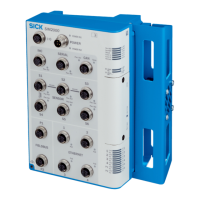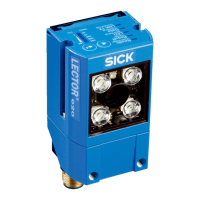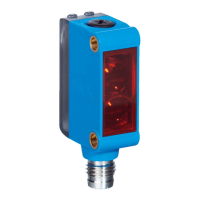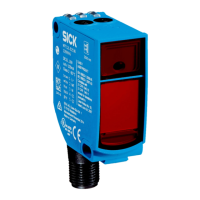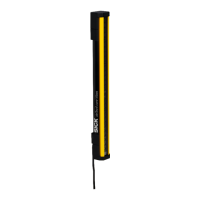Where:
•
S
L
=
protective field length, in millimeters (mm)
•
S
A
= stopping distance, in millimeters (mm)
•
TZ = tolerance zone of the device
•
Z
F
= supplement for lack of floor clearance of the vehicle, in millimeters (mm)
•
Z
B
= supplement for the decreasing braking force of the vehicle, from the vehicle
documentation, in millimeters (mm)
•
C = supplement in millimeters (mm)
Table 14: Supplement C, mobile hazardous area protection
Object resolution
H
and
Object resolution
Arm
Object resolution
Leg
Object resolution
Body
Object resolution is
no
t applicable to this
application.
Object resolution is
not applicable to this
application.
70mm 170mm
The information in the table assumes that the collision hazard is between the vehicle
and t
he legs or body of a person.
Further topics
•
"St
opping distance S
A
", page 36
•
"Approach direction", page 27
4.3.13.3 Calculation example for the protective field width
Prerequisites
•
T
he protective field in front of the vehicle is symmetrical in shape.
Calculation example for the protective field width S
B
S
B
= F
B
+ 2 × (
TZ + Z
F
)
Where:
•
S
B
= protective field width, in millimeters (mm)
•
F
B
= vehicle width, in millimeters (mm)
•
TZ = tolerance zone of the device
•
Z
F
= supplement for lack of floor clearance of the vehicle, in millimeters (mm)
4.3.13.4 Stopping distance S
A
The stopping distance is the sum of the following distances:
•
Br
aking distance of the vehicle
•
Distance traveled during the response time of the safety camera sensor
•
Distance covered during the response time of the vehicle control (incl. signal
propagation time)
A vehicle’s braking distance does not increase linearly with increasing speed, but rather
in a squared relationship.
4 P
ROJECT PLANNING
36
O P E R A T I N G I N S T R U C T I O N S | safeVisionary2 8025919/1I9E/2023-01-09 | SICK
Subject to change without notice

